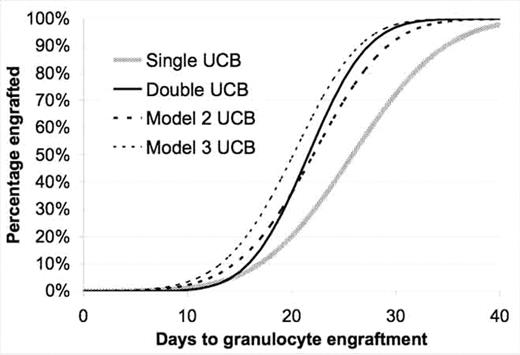Abstract
Background: The use of UCB transplants is limited by the difficulty of finding units with sufficient cells to provide reliable engraftment, and the slower kinetics of hematopoietic engraftment compared to other hematopoietic progenitor cell grafts. Grafts consisting of two unrelated UCB result in accelerated engraftment compared to single unit UCB transplants, but the mechanism for enhanced engraftment is unknown.
Methods: We extracted data from published studies on myeloid engraftment following transplantation of single (9 studies, 1542 engrafted patients) or double (4 studies, 94 engrafted patients) UCB units (Table). A weighted average of median days (and estimated SD) to engraft for single and double UCB transplants was calculated. The cumulative incidence of myeloid engraftment for single or double UCB transplants was modeled based the assumption that the time to engraft was described by a normal distribution. For double and triple UCB transplants, the probability of myeloid engraftment at any time post-transplant was calculated as 1 minus the probability of non-engraftment for a single UCB unit squared or cubed, respectively.
Results: The weighted average percentage for myeloid engraftment following single UCB transplants was 89%, with a median day of engraftment of 26.4 days. The weighted average for the rate of myeloid engraftment following double UCB transplants was 96%, with a median day of engraftment of 22 days. The calculated median days to engraft from single or double UCB transplants, using the assumption of normal distributions, were 22 and 26 days, respectively. Applying the mathematical model, the predicted cumulative engraftment for a double UCB graft is 99%, with a the curve for cumulative engraftment kinetics quite similar to the observed engraftment in Barker 2005 and the calculated curve for double UCB transplants based upon analysis of extracted data (Figure).
Conclusion: UCB units do not appear to facilitate engraftment in grafts containing multiple units. A stochastic statistical model, in which different UCB grafts engraft independently, appears to account for the observed 4-day decrease in the median time to achieve myeloid engraftment following a double versus single UCB transplant. The use of a triple UCB graft is predicted to shorten the median time to achieve neutrophil engraftment to a median of 20 days.
Published experiences describing myeloid engraftment following single and double UCB transplants
| Single UCB Transplant . | N, % engrafted . | Median day to engraft . | Double UCB Transplants . | N, % engrafted . | Median day to engraft . |
|---|---|---|---|---|---|
| Laughlin NEJM 2001 | N=61, 90% | 27 | Barker Blood 2005 | N=50, 100% | 23 |
| Hamza BJH 2004 | N=28, 86% | 29 | Yoo ASH 2005 | N=12, 100% | 23 |
| Barker Blood 2001 | N=31, 88% | 26 | Kai ASH 2004 | N=11, 82% | 21 |
| Thomson Blood 2000 | N=30, 81% | 25 | Ballen ASH 2005 | N=21, 90% | 20 |
| Sanz Blood 2001 | N=22, 100% | 22 | |||
| Terakura BBMT 2007 | N=148, 81% | 22 | |||
| Wagner Blood 2002 | N=102, 86% | 22 | |||
| Migliaccio Blood 2000 | N=200, 91% | 28 | |||
| Stevens Blood 2002 | N=1111, 90% | 27 |
| Single UCB Transplant . | N, % engrafted . | Median day to engraft . | Double UCB Transplants . | N, % engrafted . | Median day to engraft . |
|---|---|---|---|---|---|
| Laughlin NEJM 2001 | N=61, 90% | 27 | Barker Blood 2005 | N=50, 100% | 23 |
| Hamza BJH 2004 | N=28, 86% | 29 | Yoo ASH 2005 | N=12, 100% | 23 |
| Barker Blood 2001 | N=31, 88% | 26 | Kai ASH 2004 | N=11, 82% | 21 |
| Thomson Blood 2000 | N=30, 81% | 25 | Ballen ASH 2005 | N=21, 90% | 20 |
| Sanz Blood 2001 | N=22, 100% | 22 | |||
| Terakura BBMT 2007 | N=148, 81% | 22 | |||
| Wagner Blood 2002 | N=102, 86% | 22 | |||
| Migliaccio Blood 2000 | N=200, 91% | 28 | |||
| Stevens Blood 2002 | N=1111, 90% | 27 |
Figure
Author notes
Disclosure: No relevant conflicts of interest to declare.


